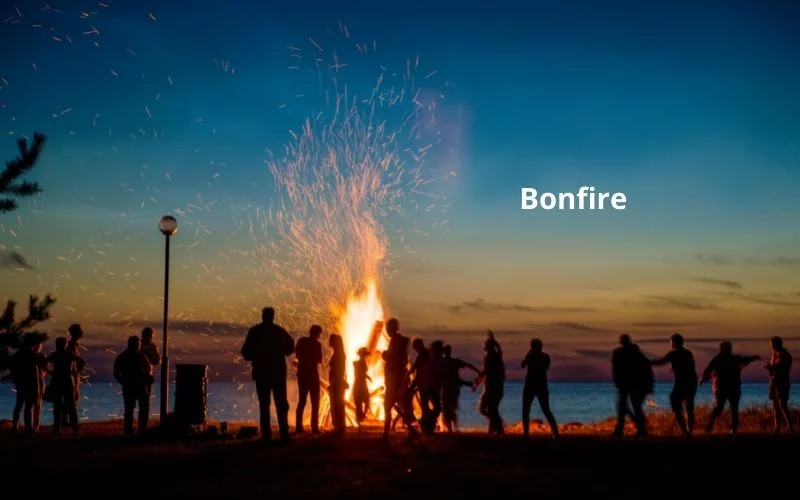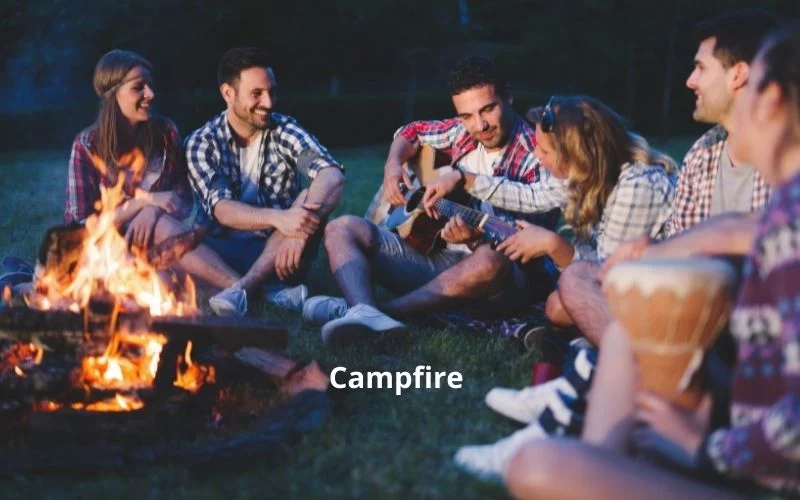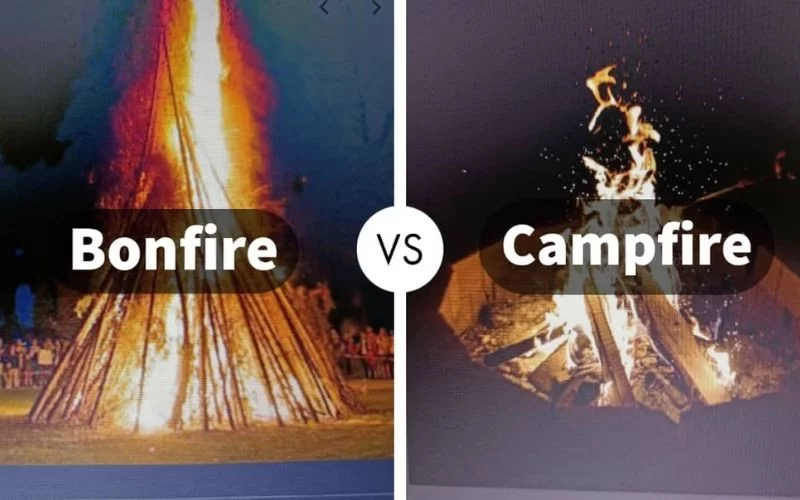There is something compelling yet mysterious about fires. The sound of a fire crackling in the outdoors is always a call to have a good time with loved ones as you roast some marshmallows, share some stories and sing songs and enjoy the warmth of the fire and the peace of nature.
Bonfires and campfires always hold a lot of fun for everyone because they create an avenue to bond in a carefree yet intimate way that you can never really get without them.
Is A Bonfire Bigger Than A campfire?
Many people use the words campfire and bonfire interchangeably, believing they all mean the same, but in reality, they are different, especially in terms of their size and purpose.
While bonfires are bigger fires that are meant for celebration with a large number of people, campfires, on the other hand, are smaller fires whose primary purpose is for cooking.
If you have a couple of friends around and you light a fire, what you have is a campfire because chances are you will be building a fire on a fire bowl or fire pit, and you might want to roast food over the fire.
On the other hand, a bonfire is a big fire for a party of a lot of people. It can also be for a religious purpose. So imagine a fire that a hundred or more people can stay around; that is how big a bonfire can get.
What Is The Difference Between Bonfire And Campfire

The differences between bonfires and campfires are solely because of the purposes for which they are made, and hence it affects the size of the fire.
Campfires are generally smaller fires that are typically contained within a fire pit that is used for practical uses, which include:
1. It is used for cooking foods like steaks, marshmallows, and other foods that do not require a lot of heat.
2. They are also a source of warmth, especially during cold evenings.
3. They are a source of entertainment because a campfire can form a focal point around which loved ones relax.
4. They are also a source of light during those very nights.
5. Campfires can be used as a mosquito repellent in the outdoors, and they are also helpful in keeping some wild animals away from the spot.
Unlike Campfires that are practical in their use, bonfires are mainly used for symbolism. Bonfires are associated with celebrations, traditions, religious and spiritual activities.
Bonfires can be used in parties, huge parties where many people converge to have fun, and the purpose is not to cook anything over the fire or even necessary for warmth; the fire elevates the party from being drab lifts up the spirit of the people there.
Many cults and religions use bonfires in their rituals to purify or depict a belief they hold firmly.
So if you have a big fire with lots of people to party with, then you’ve got a bonfire going.
But if you have a couple of friends or family over a fire pit, roasting marshmallows and having some intimate time to bond together, then we will call that a campfire.
How To Make Bonfire And Campfire

Making a bonfire or campfire is quite easy once you have all your materials ready. The only difference between how you make a bonfire that differs from how to make a campfire is that for the former, you will need to choose a bigger burn area and a lot of clearance than a campfire, and you obviously will need more woods that are bigger than you will be using in a campfire
Material You Will Need
Here are some of the materials you will need to build your bonfire or campfire
1. Tinder
Any small material that can be easily inflamed that you will need to start the fire. Some good tinder include newspapers, wood shavings, wood chips, dried leaves, candle wax, dryer lint, and pine needles. You can buy commercial fire starters or kindle.
2. Kindling
These are usually larger than kindling but smaller than logs of wood. They are mostly twigs and branches of trees that can catch fire easier than woods. The thinner your kindling, the faster your fire will catch.
3. Firewood
This is the main material that burns on a campfire or bonfire, and the better seasoned they are, the easier the fire will burn and the less smoke you will have to contend with.
If you are gathering your wood from the woods, then you are likely to burn any wood you see, but if you are buying your wood, there is a variety you can choose from that have different scents as they burn. Some common wood used in fires is Oaks, Beech, Maple, Bird, and Cherry Black.
4. Source Of Flame
A few people make fire by rubbing two stones against themselves. However, if you do not fall into this category of people with such survival skills, use a match, lighter, and other fire starters to produce the flame you will need in your bonfire or campfire.
Building The Fire
There are three main elements that you need to make a fire: are ample supply of oxygen, well-seasoned wood, and a spark source. The oxygen elements are usually taken for granted, so some fires do not burn continuously and successfully.
To build a campfire or bonfire, follow this procedure:
1. Get A Safe Location
Getting a safe spot to build your is the first step towards safety. Ensure that the place is clear from any material easily burnt by fire like trees, electrical cables, and the likes.
Sparks and embers from a crackling fire can travel some distance and land on trees, houses, and other things that might get burnt easily.
2. Make A Tinder Bed
You make your tinder bed by laying down a layer of tinder bed that is large enough to start the fire and not die out before the fire is fully ignited.
3. Add the kindling
Add your kindling in such a way that it doesn’t get stacked up with the tinder because you want to leave enough space for oxygen to get into the pile.
Arrange them so that they are close enough to burn very well but not too close to stop oxygen from circulating in a pile.
4. Add The Wood
There are different ways a house can arrange your wood to burn properly as oxygen circulates freely in a heap.
You could start with the larger wood log and then allow it to burn, or you could resort to adding the wood gradually as the flame increases.
5. Light The Heap
Now that your fire is built, you can use a lighter or a match to light the fire. You ensure that you get the flame to the fuel, which is the first to catch and then followed by the kindling before the wood logs.
Campfire And Bonfire Safety
The term ‘completely safe fire’ does not exist because fire is unpredictable and can cause colossal damage both to lives and properties if it gets out of hand; this buttresses why we always hammer on safety whenever the issue of fire comes up.
The National Park Service believes that about 85% of wildland fires in the US are caused by failure to completely kill the fires from campfires and bonfires and from the sparks and embers of the fires that reignite when they are not properly quenched.
Bonfire and campfire are some of the most volatile fires, so they must be handled with a lot of caution; here are a few ways you can safeguard yourself, loved ones, and belonging from any fire disaster.
Ensure that you contact your local fire department to get clearance to light a bonfire or campfire, also ensure to stick to any laid down procedure they give you.
Campfires and bonfires can be an inconvenience and a source of concern to your neighbors, and so you must talk to them beforehand, tell them the safety measures you have in place to ease their anxiety.
Before you start the fire, ensure that you are wearing non-flammable clothing when starting or stopping the fire. Flip flops, rubber sneakers, and shoes and wear like that should not be worn.
Choose the wood and material you will use for the fire carefully, avoid highly combustible materials and those that release fumes that are not good for the environment. Never burn damp materials like tires, plastics, foam, and stuff because they produce a lot of smoke and fumes.
Avoid throwing materials like canisters, cylinders, aerosols, and fireworks into your fire because they explode and can hurt people. The fumes they release are dangerous to the environment too.
When building your campfire or bonfire, steer clear of trees, fences, communication masts, and other properties so that they don’t get ignited mistakenly.
Fire accelerants or starters like petrol, kerosene, paraffin, gasoline, and the likes must never be used on lighting your fire because they can cause the fire to escalate and even wreak havoc.
Children and pets must not be allowed near the fire, and an adult must supervise the fire at all times, even when the fire is dying down. In the event of any fire outbreak, leave the place first and then seek help.
Because most bonfires and campfires are places where people celebrate, there is a tendency for people to take a lot more alcohol than they can handle and so constitute a hazard to themselves and others.
So for campfires and bonfires, people should lay off booze so that they don’t become clumsy and careless around the fire.
When the fire is completely burnt out, then the ember should be sprayed with water so that the chance of the fire ever reigniting is almost impossible.
Conclusion: Campfire vs Bonfire
Many people use bonfire and campfire loosely because they feel it is the same. While they both supply heat and light, they are both used for different purposes.
While campfires are meant for practical uses like cooking and repelling mosquitoes and wild animals, bonfires, on the other hand, are built for the fun of it: for the allure it gives to a gathering.
But even as you build either of these fires for any purpose, you must follow the safety guidelines elucidated earlier so that we don’t end up in a fire disaster.
By and large, whatever your purpose for making the fire, will determine how big you make it, and do not worry so much about the nomenclature of the fire in as much as it is safe for you and everyone, after all, the fire you make will answer whatever you call it.
You May Also Like:
- Are Spring Airsoft Pistols Good?
- Cost To Move a Swing Set
- How To Anchor a Metal Swing Set?
- Best Inflatable Pool Cleaner Tool
- Can You Set Up an Inflatable Pool on Concrete?
- The 5 Easiest Ways To Inflate A Pool Float
We trust this article helped you understand the difference between a Campfire vs Bonfire. You may also want to check out our article: How to Hang a Swing from a Tree Without Branches.
Thanks for taking the time to read our article, and we hope you find it helpful. Would you mind leaving a comment below if you have any suggestions?
Kindly reach out to people by sharing this post on social media.
If you liked this article, then please follow us on Facebook, Instagram, and Pinterest.

